Smart Environments
外刊英语练习题
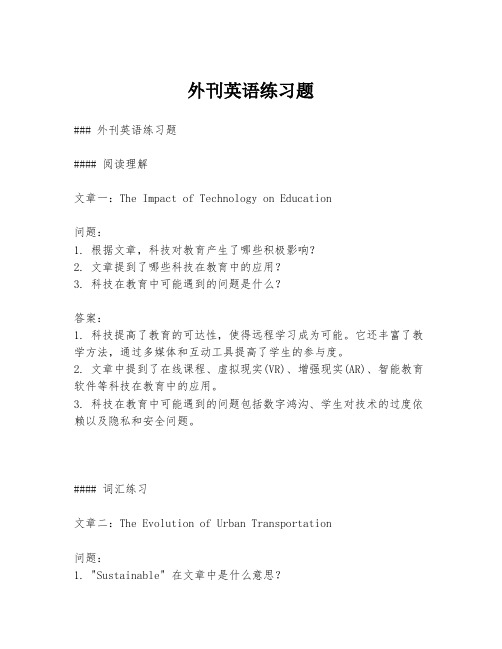
外刊英语练习题### 外刊英语练习题#### 阅读理解文章一:The Impact of Technology on Education问题:1. 根据文章,科技对教育产生了哪些积极影响?2. 文章提到了哪些科技在教育中的应用?3. 科技在教育中可能遇到的问题是什么?答案:1. 科技提高了教育的可达性,使得远程学习成为可能。
它还丰富了教学方法,通过多媒体和互动工具提高了学生的参与度。
2. 文章中提到了在线课程、虚拟现实(VR)、增强现实(AR)、智能教育软件等科技在教育中的应用。
3. 科技在教育中可能遇到的问题包括数字鸿沟、学生对技术的过度依赖以及隐私和安全问题。
#### 词汇练习文章二:The Evolution of Urban Transportation问题:1. "Sustainable" 在文章中是什么意思?2. 根据文章,哪种交通工具被认为是最环保的?3. 文章中提到的 "Smart City" 是什么概念?答案:1. "Sustainable" 在文章中指的是能够持续存在且不损害环境的。
2. 根据文章,自行车和电动车辆被认为是最环保的交通工具。
3. "Smart City" 是指利用先进的信息技术和通信系统来提高城市管理效率和居民生活质量的城市。
#### 语法填空文章三:The Benefits of Regular Exercise问题:阅读以下段落,从方框中选择适当的词填空,使文章通顺、意义完整。
Regular exercise is essential for maintaining good health. It not only helps to keep our body in shape but also boosts our immune system. Studies have shown that people who [1] (exercise) regularly are less likely to suffer from chronic diseases such as heart disease and diabetes. Moreover,exercise can improve mental health by reducing stress and anxiety. It is important to find an activity that [2] (be) enjoyable and sustainable for you.答案:1. exercise2. is#### 完形填空文章四:The Importance of Biodiversity问题:阅读以下段落,从方框中选择适当的词填空,使文章通顺、意义完整。
智慧城市包括哪些方面英语作文
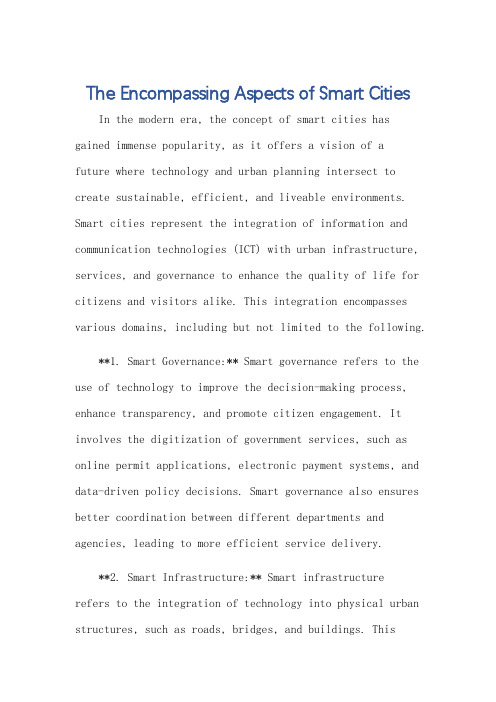
The Encompassing Aspects of Smart CitiesIn the modern era, the concept of smart cities has gained immense popularity, as it offers a vision of afuture where technology and urban planning intersect to create sustainable, efficient, and liveable environments. Smart cities represent the integration of information and communication technologies (ICT) with urban infrastructure, services, and governance to enhance the quality of life for citizens and visitors alike. This integration encompasses various domains, including but not limited to the following. **1. Smart Governance:** Smart governance refers to the use of technology to improve the decision-making process, enhance transparency, and promote citizen engagement. It involves the digitization of government services, such as online permit applications, electronic payment systems, and data-driven policy decisions. Smart governance also ensures better coordination between different departments and agencies, leading to more efficient service delivery.**2. Smart Infrastructure:** Smart infrastructurerefers to the integration of technology into physical urban structures, such as roads, bridges, and buildings. Thisincludes the use of sensors and data analytics to monitor and manage infrastructure performance, predict maintenance needs, and optimize resource allocation. For instance, smart traffic systems can adjust traffic lights and routing based on real-time traffic data, reducing congestion and travel time.**3. Smart Energy:** Smart energy systems integrate renewable energy sources, smart meters, and demand-response management to enhance energy efficiency and sustainability. These systems allow for real-time monitoring and control of energy use, enabling citizens and businesses to make informed decisions about their energy consumption. Smart energy also facilitates the integration of distributed generation, such as solar panels and wind turbines, into the grid, promoting a more resilient and sustainable energy supply.**4. Smart Mobility:** Smart mobility solutions aim to improve transportation systems, reducing congestion, emissions, and travel time. This includes the use of technologies such as GPS tracking, public transportation optimization, and shared mobility options. Smart mobilityalso encourages the use of non-motorized modes of transportation, such as cycling and walking, through the provision of infrastructure and incentives.**5. Smart Environment:** Smart environment refers to the use of technology to monitor and protect the urban ecosystem. This involves the deployment of sensors to measure air quality, noise pollution, and other environmental factors. Smart environment solutions also include the use of green infrastructure, such as parks and green roofs, to enhance urban biodiversity and improve the urban microclimate.**6. Smart Safety and Security:** Smart safety and security systems utilize advanced technologies, such as surveillance cameras, sensors, and data analytics, to enhance public safety and security. These systems can detect and respond to emergencies quickly, reducing the risk of harm to citizens and property. Smart safety and security also promote the use of proactive measures, such as crime prevention and risk mitigation, to create safer cities.In conclusion, smart cities encompass a wide range of aspects, from smart governance and infrastructure to smart energy, mobility, environment, and safety and security. The integration of technology with urban planning and services is crucial for creating sustainable, efficient, andliveable cities that meet the needs of citizens andvisitors alike. As we move forward into the future, the development and implementation of smart city solutions will become increasingly important for fostering inclusive and resilient urban environments.**智慧城市涵盖的多个方面**在现代社会,智慧城市的概念备受瞩目,因为它描绘了一个技术与城市规划交织的未来,创造了可持续、高效且宜居的环境。
中国建设智慧城市的意义英语作文

In the era of rapid urbanization and digital transformation, the development of smart cities in China has emerged as an indispensable component to foster sustainable growth, improve quality of life, and bolster economic prosperity. This essay aims to delve into the profound significance of constructing high-quality, high-standard smart cities in China from various perspectives.Firstly, from an ecological perspective, building smart cities is pivotal for achieving environmental sustainability. Smart city initiatives incorporate advanced technologies such as IoT (Internet of Things), AI (Artificial Intelligence), and big data analytics to optimize resource utilization and minimize waste. For instance, intelligent energy management systems can significantly reduce carbon emissions by optimizing power consumption patterns. Similarly, smart water management systems can prevent wastage and ensure efficient distribution. Furthermore, green transportation systems integrated with electric vehicles and smart traffic management can alleviate pollution and congestion. Hence, China's commitment to creating smart cities not only aligns with its national goals of 'ecological civilization' but also contributes to global climate action targets.Secondly, from an economic standpoint, smart cities stimulate innovation and drive economic growth. They act as incubators for high-tech industries and innovative businesses. By leveraging cutting-edge technologies, smart cities enhance productivity, streamline operations, and create new job opportunities. The digital infrastructure in smart cities attracts investments, fosters entrepreneurship, and encourages the development of a knowledge-based economy. For example, e-commerce platforms, fintech services, and smart manufacturing sectors thrive in such environments. As China moves towards a high-quality development model, the construction of smart cities plays a critical role in nurturing new economic drivers.Thirdly, in terms of social welfare, smart cities contribute to enhancing the quality of life and promoting social equity. Intelligent healthcare solutions provide more accessible and efficient medical services. Smarteducation tools bridge the gap between urban and rural areas, ensuring equal educational opportunities. Advanced public safety measures using surveillance systems and predictive analytics help maintain law and order. Moreover, smart governance ensures transparent, participatory decision-making processes, thus strengthening citizen engagement and trust in public institutions.Fourthly, on the urban planning front, smart cities address challenges associated with rapid urbanization, such as overpopulation, traffic congestion, and inadequate infrastructure. High-quality smart city design incorporates real-time monitoring and predictive analytics to manage urban resources efficiently, anticipate future demands, and plan accordingly. For instance, smart urban planning can effectively manage population flows, guide residential and commercial developments, and ensure that the city’s infrastructure is resilient and adaptable to changing needs.Lastly, from a global perspective, China's ambitious pursuit of smart city development showcases its leadership in technological innovation and urban sustainability. It sets a benchmark for other developing nations striving to balance economic progress with environmental protection and societal well-being. Through international cooperation and knowledge sharing, China's experience in smart city construction can inspire and empower global efforts towards sustainable urban development.In conclusion, the creation of high-quality, high-standard smart cities in China holds immense significance across multiple dimensions. It is a strategic step towards achieving sustainable development, fostering economic dynamism, improving living standards, managing urban complexities, and contributing to global sustainability goals. As China continues to embark on this transformative journey, the impact of these smart cities will undoubtedly reverberate far beyond their physical boundaries, shaping the future of urban living worldwide.。
智慧生活包括哪些方面的英文作文
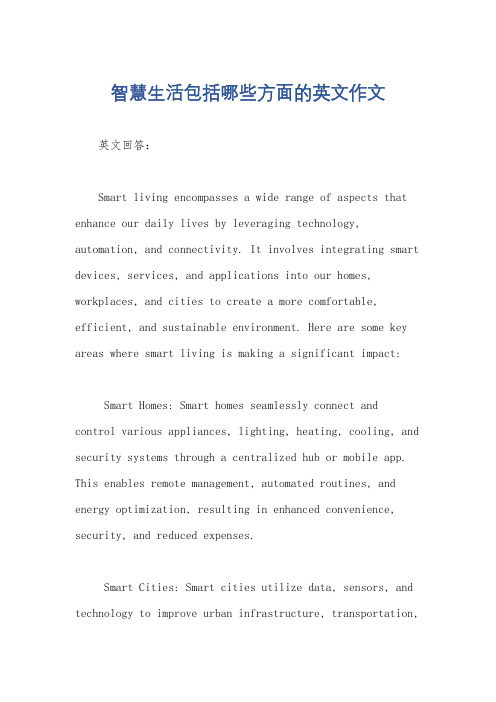
智慧生活包括哪些方面的英文作文英文回答:Smart living encompasses a wide range of aspects that enhance our daily lives by leveraging technology, automation, and connectivity. It involves integrating smart devices, services, and applications into our homes, workplaces, and cities to create a more comfortable, efficient, and sustainable environment. Here are some key areas where smart living is making a significant impact:Smart Homes: Smart homes seamlessly connect andcontrol various appliances, lighting, heating, cooling, and security systems through a centralized hub or mobile app. This enables remote management, automated routines, and energy optimization, resulting in enhanced convenience, security, and reduced expenses.Smart Cities: Smart cities utilize data, sensors, and technology to improve urban infrastructure, transportation,energy consumption, and public services. This includes implementing intelligent traffic management systems, optimizing energy distribution, and providing citizens with real-time information on city events, air quality, and transportation options.Smart Workplaces: Smart workplaces leverage technology to enhance employee productivity, collaboration, and well-being. This includes using smart office equipment, automating repetitive tasks, and creating flexible and connected workspaces that support remote and hybrid work arrangements.Smart Health: Smart health technologies empower individuals to take control of their health by monitoring vital signs, tracking fitness progress, and receiving personalized medical advice through wearable devices, mobile apps, and telemedicine services. This promotes proactive healthcare, early detection of health issues, and improved patient outcomes.Smart Transportation: Smart transportation systems useadvanced technologies such as GPS, sensors, and data analytics to optimize traffic flow, reduce congestion, and enhance safety. This includes implementing smart traffic lights, providing real-time transit information, and promoting the use of ride-sharing and electric vehicles.Smart Energy: Smart energy solutions focus on reducing energy consumption and promoting sustainability. This includes smart energy meters that monitor and control energy usage in real time, smart appliances that optimize energy efficiency, and renewable energy sources that power our homes and cities.Smart Retail: Smart retail leverages technology to enhance the customer experience, streamline operations, and optimize inventory management. This includes using self-checkout kiosks, personalized recommendations, and data analytics to improve product placement and supply chain efficiency.Smart Education: Smart education integrates technology into learning environments to improve student engagement,personalize instruction, and bridge educational gaps. This includes using virtual reality simulations, interactive whiteboards, and adaptive learning platforms that tailor lessons to individual students' needs.Smart Agriculture: Smart agriculture utilizes technology to optimize crop production, livestock management, and resource conservation. This includes using drones to monitor crop health, sensors to collect data on soil conditions, and automated irrigation systems that minimize water usage.中文回答:智慧生活涵盖了众多方面,它利用技术、自动化和连接性提升了我们的日常生活。
soundtech

soundtechIntroductionSoundtech is a cutting-edge technology that revolutionizes the way we experience sound. Whether it’s listening to music, watching movies, or playing video games, soundtech enhances the audio quality and immerses the users in a whole new level of entertainment. In this document, we will explore the various aspects of soundtech, including its benefits, applications, and future prospects.Benefits of Soundtech1.Enhanced Audio Quality: Soundtech uses advancedalgorithms and signal processing techniques to delivercrystal clear sound with improved dynamic range andfrequency response. This enhances the listening experience, making it more enjoyable and immersive.2.Noise Cancellation: Soundtech employs activenoise cancellation technology to suppress unwantedbackground noises, resulting in a cleaner and more focused audio output. This is particularly useful in environmentswith high levels of ambient noise.3.Virtual Surround Sound: Soundtech algorithmscreate a virtual surround sound effect, delivering three-dimensional audio to the users. This creates a morerealistic and engaging audio experience, especially formovies and video games.4.Personalized Audio: Soundtech enables users to customize audio settings according to their preferences. With features like equalizers and presets, users can adjust the sound output to suit their listening needs, optimizing the experience for different genres of music or content.Applications of Soundtech1.Music Industry: Soundtech has revolutionized the way we listen to music. From streaming platforms to music production, the music industry has embraced this technology to provide high-quality audio to listeners. Soundtech has also become an essential tool for music producers and engineers, enabling them to create immersive and dynamic soundscapes.2.Home Entertainment: Soundtech has greatly enhanced the home entertainment experience. With soundbars, home theaters, and smart speakers equipped with soundtech features, users can enjoy cinema-like audio quality within the comfort of their homes. The virtual surround sound feature makes movies and TV shows more immersive, while personalized audio settings provide a customized experience for every user.3.Gaming: Soundtech has become integral to gaming, enhancing the experience and competitiveness. Gamers can now accurately locate enemies and objects through surround sound, improving their reaction time and tactical advantage. The immersive audio also adds depth and realism to the gaming environment, making it more engaging and captivating.munication: Soundtech plays a crucial role in communication technologies such as teleconferencing, voice recognition, and voice assistants. Noise-canceling microphones ensure clear and intelligible communication even in noisy environments. Voice recognition systems utilize soundtech algorithms to accurately interpret and process human speech, enabling seamless and efficient interactions.Future Prospects of Soundtech1.Artificial Intelligence Integration: The future of soundtech lies in its integration with artificial intelligence (AI). AI-powered soundtech can analyze and adapt the audio output in real-time, based on user preferences and environmental factors. This will lead to a truly personalized and intelligent audio experience.2.Immersive Virtual Reality: As virtual reality (VR) technology continues to evolve, soundtech will play a crucial role in creating immersive virtual experiences. Spatial audio, combined with VR visuals, will enhance the realism and immersion, transporting users to a whole new world.3.Healthcare and Therapy: Soundtech has promising applications in the healthcare industry, particularly in therapy and rehabilitation. Music therapy, for instance, can benefit patients with mental health issues or neurological disorders. Soundtech can enhance the therapeutic effects of music by delivering precise and controlled audio stimuli.4.Smart Environments: Soundtech can be integratedinto smart home systems, creating intelligent environments that adapt to the users’ needs. For example, soundtechalgorithms can adjust audio settings based on the time of day, room acoustics, and user preferences, creating aperfect audio experience for every situation.ConclusionSoundtech has transformed the way we experience sound, enhancing audio quality, immersiveness, and personalization across various industries. From entertainment to healthcare, soundtech has a wide range of applications and promising future prospects. As technology continues to advance, we can expect soundtech to further improve and revolutionize our audio experiences in the years to come.Note: This document is written in Markdown format.。
未来智能的家英语作文
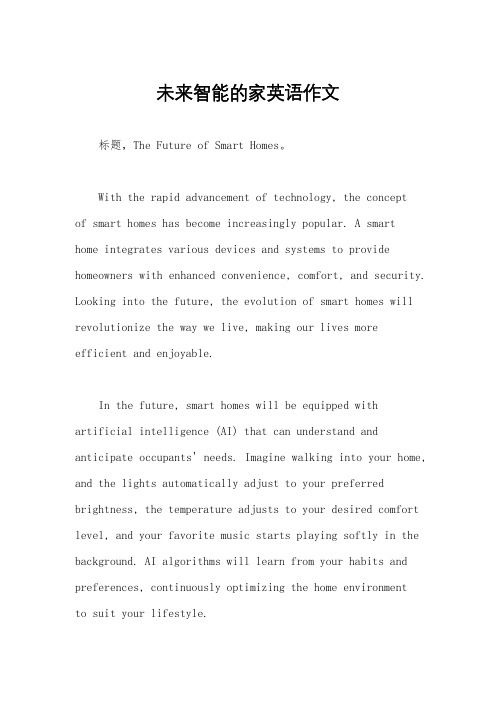
未来智能的家英语作文标题,The Future of Smart Homes。
With the rapid advancement of technology, the conceptof smart homes has become increasingly popular. A smart home integrates various devices and systems to provide homeowners with enhanced convenience, comfort, and security. Looking into the future, the evolution of smart homes will revolutionize the way we live, making our lives moreefficient and enjoyable.In the future, smart homes will be equipped withartificial intelligence (AI) that can understand and anticipate occupants' needs. Imagine walking into your home, and the lights automatically adjust to your preferred brightness, the temperature adjusts to your desired comfort level, and your favorite music starts playing softly in the background. AI algorithms will learn from your habits and preferences, continuously optimizing the home environmentto suit your lifestyle.Moreover, future smart homes will feature seamless integration of Internet of Things (IoT) devices. Every appliance and gadget will be interconnected, allowing for centralized control through smartphones or voice commands. From thermostats and lighting systems to kitchen appliances and security cameras, homeowners will have complete control over their home environment, even when they are away.One of the most significant advancements in future smart homes will be in the realm of sustainability. Energy-efficient technologies will be standard, with solar panels, smart meters, and energy storage systems powering homes while minimizing environmental impact. Smart thermostats will optimize energy usage based on occupancy patterns, and water-saving devices will help conserve this precious resource. By reducing energy consumption and promoting sustainability, smart homes will play a crucial role in combating climate change.Furthermore, future smart homes will prioritizesecurity and privacy. Advanced encryption protocols andbiometric authentication will safeguard personal data and prevent unauthorized access to smart home systems. AI-powered security systems will continuously monitor the home, detecting and responding to any potential threats in real-time. Whether it's detecting intruders or alerting homeowners to fire hazards, smart homes will provide peaceof mind and ensure the safety of occupants.The evolution of smart homes will also extend to healthcare. Integrated sensors and wearable devices will monitor occupants' health metrics, providing early warning signs of potential health issues. For example, smart bedswill analyze sleep patterns and adjust mattress firmness to promote better sleep quality. Additionally, telemedicine platforms will enable remote consultations with healthcare professionals, bringing medical care directly into the home.In terms of entertainment and leisure, future smart homes will offer immersive experiences like never before. Virtual reality (VR) and augmented reality (AR)technologies will transform living spaces into interactive environments for gaming, education, and virtual travel.Home theaters equipped with state-of-the-art sound systems and ultra-high-definition displays will provide cinematic experiences rivaling traditional cinemas.However, as we embrace the future of smart homes, it's essential to address potential challenges and concerns. Issues such as data privacy, interoperability among devices, and cybersecurity threats must be carefully managed to ensure the widespread adoption and success of smart home technology. Regulatory frameworks and industry standardswill play a crucial role in safeguarding consumer interests and promoting innovation in the smart home sector.In conclusion, the future of smart homes holds immense promise, offering unparalleled convenience, comfort, and sustainability. With advancements in AI, IoT,sustainability, security, healthcare, and entertainment, smart homes will redefine the way we live and interact with our living spaces. By embracing these innovations responsibly, we can create a future where homes are notjust smart but truly intelligent, enhancing our quality of life and shaping a better world for generations to come.。
人工智能对环境影响英语作文
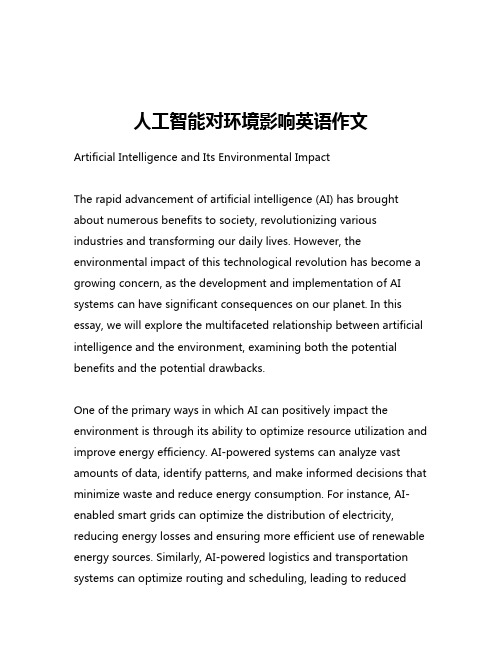
人工智能对环境影响英语作文Artificial Intelligence and Its Environmental ImpactThe rapid advancement of artificial intelligence (AI) has brought about numerous benefits to society, revolutionizing various industries and transforming our daily lives. However, the environmental impact of this technological revolution has become a growing concern, as the development and implementation of AI systems can have significant consequences on our planet. In this essay, we will explore the multifaceted relationship between artificial intelligence and the environment, examining both the potential benefits and the potential drawbacks.One of the primary ways in which AI can positively impact the environment is through its ability to optimize resource utilization and improve energy efficiency. AI-powered systems can analyze vast amounts of data, identify patterns, and make informed decisions that minimize waste and reduce energy consumption. For instance, AI-enabled smart grids can optimize the distribution of electricity, reducing energy losses and ensuring more efficient use of renewable energy sources. Similarly, AI-powered logistics and transportation systems can optimize routing and scheduling, leading to reducedfuel consumption and lower carbon emissions.Furthermore, AI can play a crucial role in environmental monitoring and conservation efforts. AI-powered sensors and satellite imagery can be used to detect and track environmental changes, such as deforestation, habitat loss, and the spread of invasive species. This information can then be used by policymakers and conservation organizations to implement targeted interventions and develop more effective strategies for protecting the environment. Additionally, AI-powered simulations and predictive models can help researchers and decision-makers better understand complex environmental systems and make more informed decisions.However, the environmental impact of AI is not limited to its potential benefits. The development and deployment of AI systems can also have significant negative consequences, particularly in terms of energy consumption and resource usage. The training and operation of AI models, especially those based on deep learning, can be highly energy-intensive, requiring vast amounts of computing power and generating significant greenhouse gas emissions. As the demand for AI-powered applications continues to grow, the energy footprint of these systems could become a significant contributor to global climate change.Moreover, the manufacture and disposal of the hardware requiredfor AI systems can also have a significant environmental impact. The extraction of raw materials, the production of electronic components, and the disposal of e-waste can all contribute to environmental degradation, pollution, and the depletion of natural resources. This issue is particularly pressing as the rapid pace of technological change often leads to the premature obsolescence of AI hardware, further exacerbating the problem of e-waste.To mitigate the environmental impact of artificial intelligence, a multifaceted approach is necessary. Researchers and developers must prioritize the development of energy-efficient AI systems, exploring ways to reduce the energy consumption of training and deployment processes. This may involve the use of more efficient hardware, the optimization of algorithms, and the incorporation of renewable energy sources into the infrastructure supporting AI systems.Additionally, the life cycle of AI hardware must be addressed, with a focus on sustainable design, responsible sourcing of materials, and the implementation of comprehensive recycling and disposal programs. Governments and policymakers can play a crucial role in this regard, by implementing regulations and incentives that encourage the development of environmentally-friendly AI technologies and the responsible management of AI-related waste.Furthermore, the integration of AI with other emerging technologies, such as renewable energy, smart city infrastructure, and sustainable agriculture, can amplify the positive environmental impact of artificial intelligence. By leveraging the power of AI to optimize these systems, we can unlock new opportunities for environmental conservation and sustainable development.In conclusion, the relationship between artificial intelligence and the environment is a complex and multifaceted one. While AI has the potential to significantly contribute to environmental protection and sustainability, its development and deployment must be carefully managed to mitigate the potential negative consequences. By prioritizing energy efficiency, responsible hardware management, and the strategic integration of AI with other sustainable technologies, we can harness the power of artificial intelligence to create a more environmentally-conscious future. As we continue to advance in the field of AI, it is crucial that we remain mindful of its environmental impact and work towards creating a harmonious balance between technological progress and environmental stewardship.。
建设智慧城市的英语作文
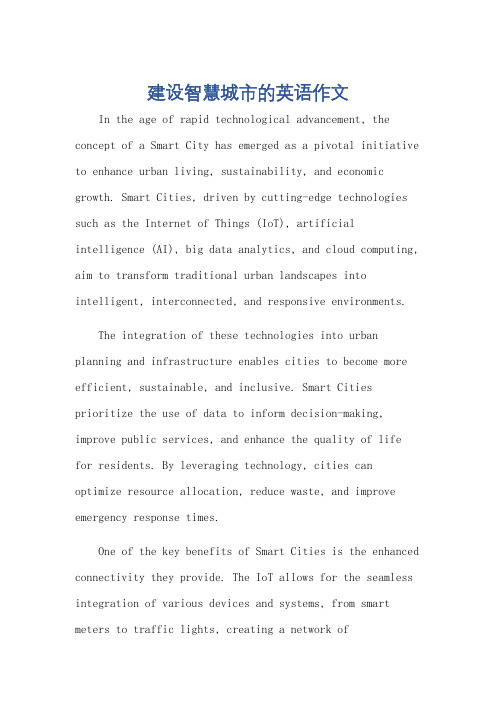
建设智慧城市的英语作文In the age of rapid technological advancement, the concept of a Smart City has emerged as a pivotal initiative to enhance urban living, sustainability, and economic growth. Smart Cities, driven by cutting-edge technologies such as the Internet of Things (IoT), artificial intelligence (AI), big data analytics, and cloud computing, aim to transform traditional urban landscapes into intelligent, interconnected, and responsive environments. The integration of these technologies into urban planning and infrastructure enables cities to become more efficient, sustainable, and inclusive. Smart Cities prioritize the use of data to inform decision-making, improve public services, and enhance the quality of lifefor residents. By leveraging technology, cities can optimize resource allocation, reduce waste, and improve emergency response times.One of the key benefits of Smart Cities is the enhanced connectivity they provide. The IoT allows for the seamless integration of various devices and systems, from smart meters to traffic lights, creating a network ofinterconnected sensors that collect and share data in real-time. This data can then be analyzed to identify patterns, predict future trends, and make informed decisions.AI also plays a crucial role in Smart City development. It enables cities to automate many tasks, such as waste management, transportation, and energy usage, reducing costs and improving efficiency. AI-driven algorithms can analyze vast amounts of data to identify areas where improvements can be made, such as optimizing traffic flow or predicting and preventing infrastructure failures.Moreover, Smart Cities promote sustainability by integrating renewable energy sources, energy-efficient buildings, and smart grid systems. These technologies help reduce carbon emissions, conserve resources, and promote a circular economy. By prioritizing sustainability, Smart Cities aim to create environments that are not only habitable but also resilient in the face of climate change and other global challenges.However, the development of Smart Cities also raises concerns about privacy, security, and inclusivity. Ascities become increasingly reliant on technology, there isa growing need to ensure that data is collected, stored,and used ethically. Additionally, Smart City initiatives must prioritize inclusivity, ensuring that all residents, regardless of their socio-economic status, can access and benefit from the technology.In conclusion, Smart Cities offer a promising path forward for urban development. By leveraging technology, cities can become more efficient, sustainable, and inclusive, providing residents with better quality of life. However, it is crucial to approach Smart City development with a balanced perspective, prioritizing privacy, security, and inclusivity alongside innovation and efficiency. As we move forward into the future, Smart Cities will play a pivotal role in shaping the way we live, work, and interact with our urban environments.**智慧城市:塑造未来的创新之路**在科技飞速发展的时代,智慧城市的概念作为提升城市生活、可持续性和经济增长的关键举措,已经崭露头角。
智慧生活包括哪些方面的英文作文

智慧生活包括哪些方面的英文作文Title: The Encompassing Aspects of Smart Living.In today's rapidly advancing technological era, the concept of smart living has become increasingly prevalent, transforming the way we interact with our surroundings and enhancing our quality of life. Smart living encompasses a diverse range of technologies and applications that span from our homes to our daily commutes, workplaces, and beyond. This essay delves into the various facets of smart living, exploring how they intersect with our daily lives and the future they promise.Home Automation.Home automation is a pivotal aspect of smart living, revolutionizing the domestic sphere. It involves the integration of technologies such as smart speakers, smart thermostats, and security systems that can be controlled remotely through smartphones or voice commands. This notonly makes life more convenient but also enhances safetyand energy efficiency. For instance, smart thermostats can adjust the indoor temperature based on occupancy andexternal weather conditions, saving energy while ensuring optimal comfort.Smart Appliances.Another crucial aspect is the emergence of smart appliances. These range from refrigerators that can monitor their contents and order groceries when needed to washing machines that can detect the type of fabric and adjust the wash cycle accordingly. These appliances not only make our lives easier but also contribute to resource optimization and waste reduction.Connected Health.In the realm of healthcare, smart living is manifesting through connected health devices and applications. These include wearables that track health metrics like heart rate, sleep quality, and fitness goals. Additionally, remotemonitoring systems allow doctors to keep tabs on patients' health remotely, enabling timely interventions and reducing the need for hospital visits.Smart Transportation.Smart transportation systems are transforming how we travel. This includes intelligent traffic management systems that optimize traffic flow, reducing congestion and travel time. Autonomous vehicles and ride-sharing services are also becoming increasingly prevalent, providing safer, more convenient, and environmentally friendlytransportation options.Smart Cities.On a larger scale, smart cities represent a comprehensive approach to smart living. These cities are designed to use technology to enhance the lives of their residents. This includes smart grid systems for efficient energy distribution, water management systems to conserve water resources, and smart security systems to enhancepublic safety. Smart cities also prioritize sustainable development, ensuring that economic growth, social well-being, and environmental protection are balanced.Smart Offices.In the workplace, smart living is reflected in smart office designs. This involves the integration of technology that enhances productivity, collaboration, and employee well-being. Smart office systems can adjust lighting and temperature based on occupancy, reduce energy waste, and promote a more comfortable work environment. Additionally, remote work tools have become increasingly common, allowing employees to work flexibly from anywhere, enhancing work-life balance.Smart Education.Education is also undergoing a transformation with smart living. The integration of technology in the classroom has made learning more interactive and engaging. Smartboards, virtual reality, and online learning platformsare revolutionizing teaching methods, personalizing learning experiences, and providing access to education regardless of location.In conclusion, smart living is a diverse and encompassing concept that spans various aspects of our daily lives. It promises a future where technology seamlessly integrates with our environments, enhancing our quality of life, improving efficiency, and fostering sustainable development. As we continue to embrace these technologies, the possibilities for smart living are limitless.。
智能机器改变生活英语作文
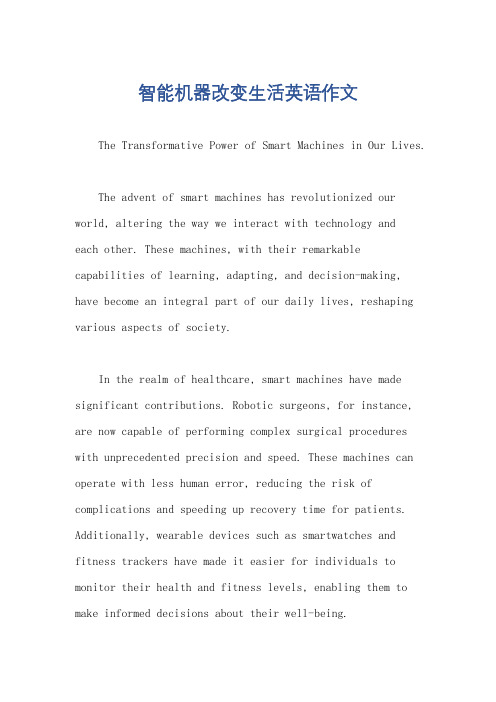
智能机器改变生活英语作文The Transformative Power of Smart Machines in Our Lives.The advent of smart machines has revolutionized our world, altering the way we interact with technology andeach other. These machines, with their remarkablecapabilities of learning, adapting, and decision-making, have become an integral part of our daily lives, reshaping various aspects of society.In the realm of healthcare, smart machines have made significant contributions. Robotic surgeons, for instance, are now capable of performing complex surgical procedures with unprecedented precision and speed. These machines can operate with less human error, reducing the risk of complications and speeding up recovery time for patients. Additionally, wearable devices such as smartwatches and fitness trackers have made it easier for individuals to monitor their health and fitness levels, enabling them to make informed decisions about their well-being.The field of education has also been profoundly impacted by smart machines. Adaptive learning platforms use artificial intelligence to tailor educational content to the needs and abilities of individual students. These platforms adjust the difficulty level of questions and provide personalized feedback, enabling students to learn more effectively. Furthermore, virtual reality and augmented reality technologies have transformed the way we learn, immersing students in interactive and engaging environments that foster deeper understanding and retention of information.In the workplace, smart machines have revolutionized productivity and efficiency. Automation has replaced many manual tasks, freeing up workers to focus on more complex and创新性的任务。
智慧生态例子英文作文

智慧生态例子英文作文英文:Smart ecology is a term that refers to the integration of technology and nature to create sustainable andefficient systems. In my opinion, one great example of a smart ecology is the implementation of smart irrigation systems in agriculture.Traditional irrigation methods often waste water and can lead to over-watering or under-watering of crops. Smart irrigation systems use sensors and technology to monitor soil moisture levels and weather patterns, and adjust watering accordingly. This not only saves water, but also ensures that crops receive the optimal amount of water for their growth.Another example of smart ecology is the use of green roofs in urban areas. Green roofs are covered in vegetation and can help reduce the urban heat island effect, improveair quality, and provide habitat for wildlife. They canalso help reduce stormwater runoff and improve energy efficiency in buildings.Overall, smart ecology is about finding innovative ways to use technology to enhance and work with nature, rather than against it. By doing so, we can create moresustainable and efficient systems that benefit both the environment and human society.中文:智慧生态是指将技术与自然融合,创建可持续和高效的系统。
智能城市的好处英语作文

智能城市:未来生活的新篇章In the rapidly evolving technological landscape, the concept of a Smart City has emerged as a pivotal initiative to enhance the quality of life and sustainability of urban environments. Smart Cities leverage cutting-edge technologies such as artificial intelligence, the Internet of Things (IoT), big data analytics, and cloud computing to create intelligent, interconnected systems that optimize resource allocation, enhance public services, and improve citizens' well-being.The primary benefit of Smart Cities is their ability to improve the efficiency and effectiveness of urban operations. For instance, smart traffic management systems can predict and adapt to traffic patterns, reducing congestion and travel times. Smart metering systems for utilities like water, electricity, and gas allow for precise monitoring and conservation, leading to cost savings and resource optimization. Similarly, smart waste management systems can reduce the environmental impact of waste disposal by optimizing collection routes andrecycling rates.Smart Cities also enhance public safety and security. By integrating surveillance cameras, sensors, and real-time data analysis, these cities can detect and respond to emergencies more quickly. For instance, early warning systems for natural disasters like floods or earthquakes can save lives by providing advance notice to citizens. Additionally, smart policing systems can improve law enforcement efficiency by analyzing crime patterns and deploying resources more strategically.Moreover, Smart Cities foster innovation and economic growth. They attract talent and investment by providing a platform for innovation and collaboration. Smart City initiatives can also create new business opportunities, such as developing smart solutions for transportation, healthcare, education, and entertainment. These opportunities drive economic growth and create jobs, leading to a more prosperous and diverse urban landscape. Additionally, Smart Cities promote social inclusivity and citizen engagement. By providing access to digital services and information, they empower citizens to participate more actively in the decision-making process.Smart City platforms allow for citizen feedback and engagement, fostering a sense of community and ownership over urban development. This inclusivity ensures that the benefits of Smart City initiatives are shared by all members of society.In conclusion, Smart Cities offer a range of benefits that transform urban environments into more efficient, sustainable, and inclusive spaces. By leveraging cutting-edge technologies, Smart Cities enhance the quality of life for citizens, improve public services, and foster economic growth. As we move into the future, the development ofSmart Cities will play a pivotal role in shaping the way we live, work, and interact with our urban environments.**智能城市:未来生活的新篇章**在科技飞速发展的当下,智能城市的概念已经崭露头角,成为提升城市生活质量和可持续性的关键举措。
互联智慧教育的英语作文

In the era of rapid technological advancement,the concept of interconnected smart education has emerged as a revolutionary approach to learning.This essay will delve into the various facets of interconnected smart education,exploring its potential to transform the educational landscape.The Evolution of Smart EducationSmart education has evolved from traditional classroom teaching to a more interactive and personalized learning experience.With the integration of technology,students can access a wealth of information and resources at their fingertips.This shift has been facilitated by the development of educational software,online platforms,and digital tools that cater to different learning styles and needs.Interconnectedness in EducationThe essence of interconnected smart education lies in its ability to connect various elements of the learning process.This includes connecting students with teachers, curriculum with realworld applications,and educational institutions with global knowledge networks.The internet serves as a backbone,enabling seamless communication and collaboration among all stakeholders in the educational ecosystem.Technological Advancements Supporting Smart EducationSeveral technological advancements have been pivotal in shaping smart education:1.Artificial Intelligence AI:AIpowered tools can analyze student performance and tailor educational content to meet individual needs,thus personalizing the learning experience.2.Virtual Reality VR and Augmented Reality AR:These immersive technologies can simulate realworld environments,offering experiential learning opportunities that were previously unattainable.3.Big Data Analytics:The analysis of large datasets helps educators understand trends, predict student outcomes,and make informed decisions about curriculum development and teaching strategies.4.Cloud Computing:Cloudbased platforms allow for the storage and sharing of educational resources,making them accessible anytime and anywhere.Challenges and SolutionsDespite the numerous benefits,interconnected smart education also faces challenges such as digital divide,data privacy concerns,and the need for continuous professional development for educators.Addressing these issues requires a concerted effort from governments,educational institutions,and technology providers to ensure equitable access to technology and robust data protection measures.The Future of Interconnected Smart EducationLooking ahead,interconnected smart education is set to become even more integrated with advancements in machine learning,blockchain for secure recordkeeping,and the Internet of Things IoT for creating smart learning environments.The goal is to create a global learning community where knowledge is shared,and educational opportunities are limitless.ConclusionInterconnected smart education represents a significant leap forward in the way we approach learning.By harnessing the power of technology and fostering a connected learning environment,we can empower students to reach their full potential and prepare them for the challenges of the future.It is a dynamic and evolving field that holds great promise for transforming the educational experience for the better.。
智能城市的好处英语作文

Smart Cities: The Pathway to a BetterFutureIn the fast-paced world of technology, smart cities have emerged as the epitome of urban development, promising a more efficient, sustainable, and connected future. These cities are designed to harness the power of technology to enhance the lives of their residents, making it easier for them to access services, information, and resources.One of the primary benefits of smart cities is the improved quality of life they offer. With the integration of technology into various aspects of urban life, residents can enjoy better healthcare, education, transportation, and public safety. Smart healthcare systems, for instance, can provide real-time data on patients' health, enabling doctors to make more informed decisions. Smart transportation systems can reduce congestion and pollution by efficiently routing vehicles and public transportation.Another significant advantage of smart cities is theirsustainability. By using data analytics and smart technologies, cities can better manage their resources, reducing waste and energy consumption. Smart metering systems can monitor and control the usage of water, gas, and electricity, ensuring efficient distribution and usage. Additionally, smart cities promote the use of renewable energy sources, such as solar and wind power, further reducing their carbon footprint.Moreover, smart cities foster innovation and economic growth. They provide a platform for businesses to collaborate, innovate, and expand, attracting investors and talent. Smart technologies can also help create new job opportunities, such as in the fields of data analytics, cybersecurity, and technology development.However, the benefits of smart cities are not limited to residents and businesses. Governments also stand to gain from the efficiency and transparency offered by smart technologies. For instance, smart governance systems can improve decision-making by providing real-time data on various aspects of city operations. This data can help policymakers make informeddecisions that benefit the city and its residents.In conclusion, smart cities offer a range of benefits that span from improved quality of life to sustainable development and economic growth. By harnessing the power of technology, these cities are paving the way for a more efficient, sustainable, and connected future. While there are challenges to overcome, such as data privacy and security, the potential of smart cities is vast, and the world is eagerly anticipating their further evolution.**智慧城市:通往更好未来的道路**在快速发展的科技世界中,智能城市已崭露头角,作为城市发展的典范,预示着更高效、更可持续、更紧密的未来。
智能家居未来 英语作文
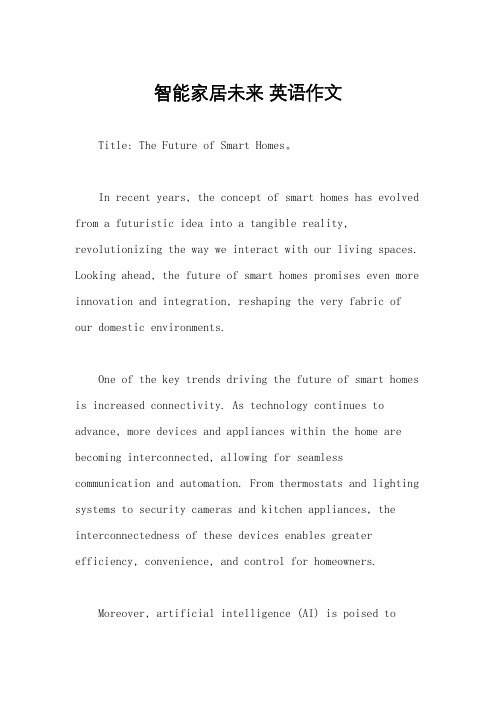
智能家居未来英语作文Title: The Future of Smart Homes。
In recent years, the concept of smart homes has evolved from a futuristic idea into a tangible reality, revolutionizing the way we interact with our living spaces. Looking ahead, the future of smart homes promises even more innovation and integration, reshaping the very fabric of our domestic environments.One of the key trends driving the future of smart homes is increased connectivity. As technology continues to advance, more devices and appliances within the home are becoming interconnected, allowing for seamless communication and automation. From thermostats and lighting systems to security cameras and kitchen appliances, the interconnectedness of these devices enables greater efficiency, convenience, and control for homeowners.Moreover, artificial intelligence (AI) is poised toplay a central role in the future of smart homes. AI-powered assistants, such as Amazon's Alexa, Google Assistant, and Apple's Siri, are already transforming how we interact with our homes. These assistants can perform a wide range of tasks, from adjusting the temperature and playing music to ordering groceries and managing schedules. As AI technology continues to improve, these assistantswill become even more intuitive and personalized, learning from our habits and preferences to anticipate our needs before we even express them.In addition to increased connectivity and AI integration, the future of smart homes will also prioritize sustainability and energy efficiency. With growing concerns about climate change and environmental sustainability, homeowners are increasingly seeking ways to reduce their carbon footprint and conserve energy. Smart home technology offers numerous solutions in this regard, from energy-efficient appliances and smart thermostats to solar panels and automated lighting systems. By intelligently managing energy consumption and optimizing resource usage, smart homes can help reduce energy waste and lower utility billswhile contributing to a more sustainable future.Furthermore, the future of smart homes will be characterized by enhanced security and privacy features. As more devices within the home become connected to the internet, the risk of cyber threats and data breaches also increases. To address these concerns, manufacturers and developers are implementing robust security protocols and encryption standards to protect sensitive data and ensure user privacy. Additionally, advances in biometric authentication and facial recognition technology are making smart homes more secure than ever before, allowing homeowners to control access to their homes and monitor activity remotely.Looking ahead, the future of smart homes holds immense promise for transforming the way we live, work, andinteract with our surroundings. With continued advancements in technology and innovation, smart homes will become increasingly interconnected, intelligent, sustainable, and secure, offering homeowners unprecedented levels of convenience, comfort, and peace of mind.In conclusion, the future of smart homes is bright,with endless possibilities for innovation and improvement. By embracing connectivity, artificial intelligence, sustainability, and security, smart homes will continue to redefine the concept of modern living, making our lives easier, more efficient, and more enjoyable than ever before.。
智能化场景英语作文

智能化场景英语作文Title: Embracing the Era of Smart Environments。
In today's rapidly evolving world, the integration of technology into various aspects of our lives has become inevitable. One prominent manifestation of this integration is the emergence of smart environments, where interconnected devices and intelligent systems work together to enhance efficiency, convenience, and comfort. In this essay, we will explore the significance of smart environments and their implications for individuals and society.To begin with, smart environments encompass a wide range of settings, including smart homes, smart cities, and smart workplaces. These environments leverage technologies such as the Internet of Things (IoT), artificial intelligence (AI), and data analytics to collect and analyze information, automate processes, and optimize resource utilization. For instance, in a smart home,sensors embedded in appliances, lighting, and security systems can monitor and adjust settings based on occupants' preferences and behavior patterns, thereby promoting energy conservation and enhancing security.One of the primary benefits of smart environments is their ability to improve efficiency and productivity. By automating routine tasks and providing real-time insights, these environments enable individuals to focus their time and energy on more meaningful activities. For example, in a smart office, employees can use IoT-enabled devices and smart scheduling systems to streamline meetings, coordinate tasks, and allocate resources efficiently, leading to greater productivity and collaboration.Moreover, smart environments have the potential to enhance safety and security. Through the integration of sensors, cameras, and intelligent algorithms, these environments can detect and respond to potential threats or emergencies in a timely manner. For instance, in a smart city, surveillance cameras equipped with facial recognition technology can help law enforcement agencies identify andtrack suspicious individuals, while smart traffic management systems can optimize traffic flow and minimize accidents.In addition to improving efficiency and safety, smart environments also have profound implications for sustainability and environmental conservation. By monitoring and optimizing resource consumption, such as energy and water usage, these environments can reduce waste and minimize environmental impact. Furthermore, by promoting the use of renewable energy sources and encouraging sustainable practices, such as recycling and composting, smart environments can contribute to the global efforts to address climate change and build a more sustainable future.However, it is essential to recognize that the widespread adoption of smart environments also raises important ethical, privacy, and security concerns. As these environments collect vast amounts of data aboutindividuals' activities, preferences, and behaviors, there is a risk of misuse or unauthorized access to thisinformation. Therefore, it is crucial to implement robust security measures, such as encryption, access controls, and data anonymization, to protect individuals' privacy and prevent data breaches.Furthermore, the deployment of smart environments should be accompanied by comprehensive regulations and guidelines to ensure ethical use and prevent potential abuses of power. Governments, industry stakeholders, and civil society organizations must collaborate to establish clear standards for data governance, transparency, and accountability in the design and operation of smart environments.In conclusion, the advent of smart environments represents a transformative shift in the way we interact with our surroundings and harness technology to improve our lives. By leveraging the power of connectivity, artificial intelligence, and data analytics, these environments have the potential to enhance efficiency, productivity, safety, and sustainability. However, realizing the full potential of smart environments requires careful consideration ofethical, privacy, and security implications, as well as concerted efforts to establish regulatory frameworks that safeguard individuals' rights and interests. As we continue to embrace the era of smart environments, it is essential to strike a balance between innovation and responsibility to create a future that is not only technologically advanced but also ethical, inclusive, and sustainable.。
智能宿舍英文作文
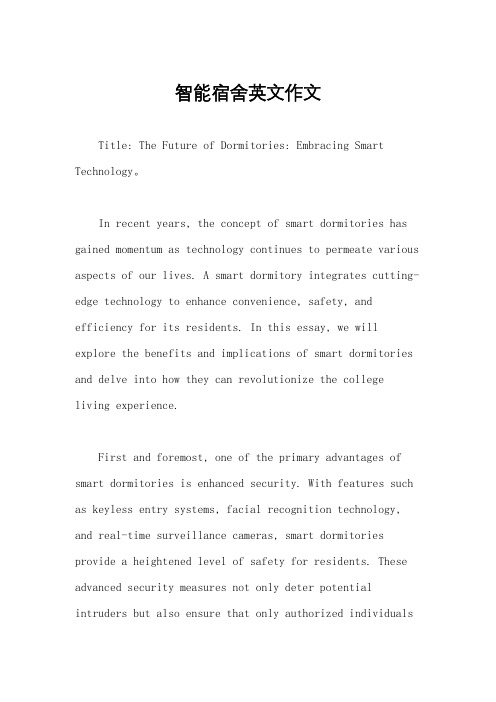
智能宿舍英文作文Title: The Future of Dormitories: Embracing Smart Technology。
In recent years, the concept of smart dormitories has gained momentum as technology continues to permeate various aspects of our lives. A smart dormitory integrates cutting-edge technology to enhance convenience, safety, and efficiency for its residents. In this essay, we will explore the benefits and implications of smart dormitories and delve into how they can revolutionize the collegeliving experience.First and foremost, one of the primary advantages of smart dormitories is enhanced security. With features such as keyless entry systems, facial recognition technology, and real-time surveillance cameras, smart dormitories provide a heightened level of safety for residents. These advanced security measures not only deter potential intruders but also ensure that only authorized individualshave access to the premises, thereby creating a secureliving environment conducive to academic success and personal well-being.Moreover, smart dormitories offer unparalleled convenience through automation and connectivity. Imagine being able to control the lighting, temperature, and entertainment systems in your dorm room with a simple voice command or smartphone app. Smart devices such as smart thermostats, smart speakers, and smart appliancesstreamline daily tasks and optimize comfort, allowing students to focus more on their studies and extracurricular activities without being bogged down by mundane chores.Furthermore, the integration of IoT (Internet of Things) technology in smart dormitories facilitates efficient resource management and energy conservation. Sensors embedded in various appliances and fixtures can monitor usage patterns and automatically adjust settings tominimize waste and reduce utility costs. For instance,lights and air conditioning systems can be programmed toturn off when rooms are unoccupied, while water usage canbe regulated to prevent unnecessary wastage. By promoting sustainability and environmental responsibility, smart dormitories contribute to a greener campus and foster eco-conscious habits among residents.In addition to security, convenience, andsustainability, smart dormitories also offer opportunities for enhanced community engagement and social connectivity. Collaborative spaces equipped with interactive displays, virtual reality consoles, and multimedia amenities encourage interaction and collaboration among residents, fostering a sense of camaraderie and belonging. Furthermore, integrated social networking platforms and communication tools facilitate seamless communication and coordination among students, enabling them to organize events, study groups, and recreational activities more effectively.However, despite the numerous benefits of smart dormitories, there are also potential challenges and considerations that need to be addressed. One concern isthe issue of privacy and data security. With theproliferation of interconnected devices and sensors, thereis a risk of sensitive personal information being compromised or exploited. It is imperative for institutions to implement robust cybersecurity measures and privacy protocols to safeguard the confidentiality and integrity of residents' data.Another consideration is the digital divide, which refers to the gap between individuals who have access to technology and those who do not. While smart dormitories offer advanced amenities and connectivity, not all students may have equal access to these resources due to socioeconomic disparities or technological barriers. Therefore, it is essential for universities to ensure equitable access to smart dormitory facilities and provide support for students who may require assistance in navigating and utilizing technology.In conclusion, smart dormitories represent the future of student housing, offering a myriad of benefits ranging from enhanced security and convenience to sustainability and community engagement. By leveraging the power of technology, universities can create dynamic livingenvironments that empower students to thrive academically, socially, and environmentally. However, it is crucial to address potential challenges such as privacy concerns and digital inequality to ensure that the benefits of smart dormitories are accessible to all students. With careful planning and implementation, smart dormitories have the potential to revolutionize the college living experience and shape the future of higher education.。
智慧学习环境中情境模型的构建及表征

Learning Context Model in Smart Learning
Environments
作者: 李青[1,2];祁红[2]
作者机构: [1]北京师范大学未来教育高精尖创新中心,北京100875;[2]北京邮电大学网络教育学院,北京100876
出版物刊名: 现代教育技术
页码: 95-102页
年卷期: 2017年 第8期
主题词: 情境模型;智慧学习环境;泛在学习;表征方法
摘要:在智慧学习环境中,要想让学习者投入、高效并个性化地学习,需要构建情境模型。
文章综述了国内外学习管理系统中学习情境建模研究的现状,并通过对智慧学习环境特征的分析,提出了一种新的学习情境模型。
该模型通过感知设备,获取并存储学习者在智慧情境中触碰的相关物理要素而产生的数据,对其进行分析和推断,并结合学习者的个性化需求有针对性地适配预设学习方案,提供"智能化"的学习服务。
文章还利用XML语言规范了学习情境模型的表征方法,并以一个具体的实例加以说明。
最后,文章还讨论了该情境模型在智慧学习环境平台软件中的实际应用。
介绍智慧城市英文作文
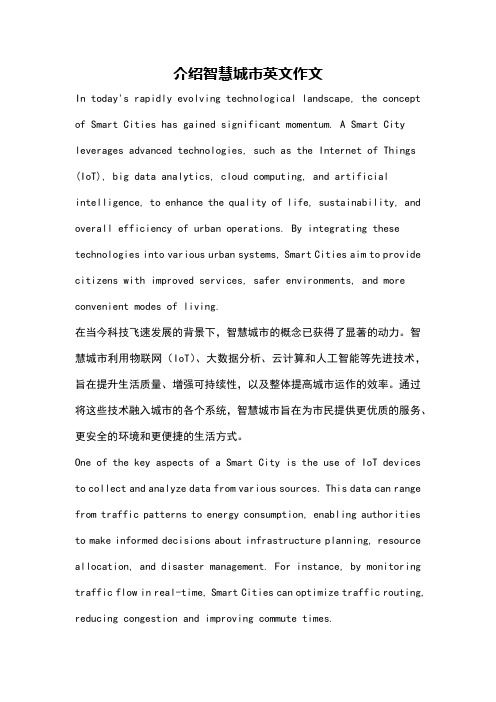
介绍智慧城市英文作文In today's rapidly evolving technological landscape, the concept of Smart Cities has gained significant momentum. A Smart City leverages advanced technologies, such as the Internet of Things (IoT), big data analytics, cloud computing, and artificial intelligence, to enhance the quality of life, sustainability, and overall efficiency of urban operations. By integrating these technologies into various urban systems, Smart Cities aim to provide citizens with improved services, safer environments, and more convenient modes of living.在当今科技飞速发展的背景下,智慧城市的概念已获得了显著的动力。
智慧城市利用物联网(IoT)、大数据分析、云计算和人工智能等先进技术,旨在提升生活质量、增强可持续性,以及整体提高城市运作的效率。
通过将这些技术融入城市的各个系统,智慧城市旨在为市民提供更优质的服务、更安全的环境和更便捷的生活方式。
One of the key aspects of a Smart City is the use of IoT devices to collect and analyze data from various sources. This data can range from traffic patterns to energy consumption, enabling authorities to make informed decisions about infrastructure planning, resource allocation, and disaster management. For instance, by monitoring traffic flow in real-time, Smart Cities can optimize traffic routing, reducing congestion and improving commute times.智慧城市的一个关键方面是利用物联网设备从各种来源收集和分析数据。
智能科技进入我们的生活 英语作文 简单

Smart Technology in Our LivesIn today's world, the integration of smart technology into our daily lives is becoming increasingly prominent. From smartphones and smartwatches to smart homes and smart cities, these advancements are revolutionizing the way we live, work, and interact with the world.The rise of smartphones has been particularly noteworthy. These devices have become extensions of our hands, providing us with instant access to information, communication, and entertainment. We can now browse the internet, make phone calls, send emails, take photos, and even control other smart devices with just a few taps on our screens.Smart homes are also gaining popularity, as they offer convenience and efficiency. With smart devices like thermostats, lighting systems, and security cameras, we can control our home environments remotely and automate tasks like adjusting the temperature or turning off the lights. This not only saves time and energy but also enhances our overall comfort and safety.Moreover, smart cities are emerging as a new frontierin urban development. By using data analytics and the Internet of Things (IoT), these cities are able to optimize traffic flow, reduce energy consumption, and improve public services. For instance, smart traffic systems can adjust traffic signals based on real-time data to reduce congestion, while smart grids can optimize energydistribution to reduce waste.However, the widespread adoption of smart technology also brings challenges. Privacy concerns are at the forefront, as more and more personal data is beingcollected and analyzed by these devices and systems. It is crucial that we establish robust privacy policies and regulations to protect our personal information.Additionally, the digital divide is another issue that needs to be addressed. While many people enjoy the benefits of smart technology, there are still those who lack accessto these advancements due to factors like income, education, or geographic location. It is essential that we worktowards ensuring that everyone has equal access to the opportunities and benefits that smart technology brings.In conclusion, smart technology is transforming ourlives in numerous ways, offering convenience, efficiency, and new opportunities. However, it is important that wealso address the challenges that arise from its widespread adoption, such as privacy concerns and the digital divide. As we continue to embrace smart technology, it is crucial that we do so in a responsible and inclusive manner.**智能科技在我们的生活中**在当今世界,智能科技越来越多地融入我们的日常生活,从智能手机和智能手表到智能家居和智慧城市,这些进步正在改变我们的生活方式、工作方式和与世界互动的方式。
- 1、下载文档前请自行甄别文档内容的完整性,平台不提供额外的编辑、内容补充、找答案等附加服务。
- 2、"仅部分预览"的文档,不可在线预览部分如存在完整性等问题,可反馈申请退款(可完整预览的文档不适用该条件!)。
- 3、如文档侵犯您的权益,请联系客服反馈,我们会尽快为您处理(人工客服工作时间:9:00-18:30)。
Smart EnvironmentsZhuo-Fei HuiTechnische Universität BerlinStraße des17.Juni135Berlin,Deutschlandzfhui@ABSTRACTIn dieser Arbeit werden einige aktuelle Entwicklungen zum Thema“Intelligente Umgebungen“vorgestellt.Dabei bezieht sich die Auswahl der Forschungsarbeiten auf den Einsatz von Technologien in h¨a uslichen Umgebungen.Hauptziel die-ser Arbeit ist es,anhand der Darstellung einiger Projek-te zun¨a chst aufzuzeigen,wie breit gef¨a chert die Forschung auf diesem Gebiet ist.Daf¨u r werden Objekte wie Talking Magnets,Picture Bowl oder History Tablecloth vorgestellt und ihre Funktionsweise erl¨a utert.Außerdem soll er¨o rtert werden,welchen zus¨a tzlichen Wert,jenseits von der reinen Funktionalit¨a t,wir durch die Nutzung von diesen Technolo-gien f¨u r unser Leben gewinnen.KeywordsIntelligente Umgebung,h¨a usliche Technologien,materielle Oberfl¨a che,History Tablecloth Interpretation,¨Astehtik 1.EINLEITUNGDas Wort“Intelligenz“kann in vielerlei Hinsicht interpretiert werden.Schnelles Auffassungsverm¨o gen,Kreativit¨a t,...sind nur einige Schlagw¨o rter,die mit diesem Begriffin Assoziati-on gebracht werden.Setzt man diesen Begriffmit dem Ein-satz von Technik in h¨a uslicher Umgebung in Verbindung, denkt man schnell an Robotern oder Maschinen,die kom-plexe Aufgaben erledigen sollen und somit Teile von unse-ren h¨a uslichen Aufgaben¨u bernehmen k¨o nnen.Bei genauerer Auseinandersetzung mit den gegenw¨a rtigen Forschungsthe-men stellt sich jedoch schnell eine andere Auffassung des Intelligenzbegriffs heraus.we think of the home as already smart,smartnot in terms of technology,but in terms of howpeople conduct their lives in the home.[2]Es wird unter intelligenter Umgebung die Einbettung von innovativen Technologien in unserem allt¨a glichen Leben ver-standen,wodurch unsere h¨a uslichen Aufgaben mehr unter-st¨u tzt als¨u bernommen werden.Basierend auf unserem Ver-halten und unseren Bed¨u rfnissen im allt¨a glichen Leben ar-beiten zahlreiche Forschungsteams an der Entwicklung und Umsetzung von neuen Ideen,die genau dieses Ziel verfol-gen.Dabei entstehen Objekte,die zum Teil rein praktische Funktionen haben,aber auch zum Teil interessante Aspekte unseres Alltags aufwerfen und uns so dazu bringen inne zu halten und etwas genauer¨u ber unsere materielle Umgebung, unser soziales Umfeld und¨u ber unser allt¨a gliches,vielleicht auf den ersten Blick banales Verhaltens nachzudenken. Diese Arbeit wird sich mit der Vorstellung einiger dieser Ideen und deren Umsetzung besch¨a ftigen.Dabei habe ich aus zahlreichen aktuellen Forschungsprojekten zum Thema smart environments zwei ausgesucht,die,meiner Meinung nach,gut einen Einblick auf dieses Gebiet bieten.Das erste Projekt besch¨a ftigt sich haupts¨a chlich mit der Entwicklung von Objekten,die sich auf ihre praktische Nutzung konzen-triert.Im Gegensatz dazu f¨a llt das zweite Projekt etwas aus dem Rahmen,liefert jedoch in seiner Bedeutung viel mehr Diskussionsstoffzur weiteren Auseinandersetzung.2.SMART HOMEDurchgef¨u hrt vom der Socio-Digital Systems Group bei Mi-crosoft Research in Cambridge,werden im Rahmen des Pro-jekts smart home[2]Objekte entwickelt,die sehr eng mit unserem Verhalten im allt¨a glichen Leben und den M¨o glich-keiten,die uns unsere Umgebung bietet,verbunden sind.Der Fokus wird hierbei auf materielle Oberfl¨a chen in Wohnr¨a u-men gesetzt.Die meisten Haushalte nutzen schon vorhan-dene materielle Oberfl¨a chen auf sehr intelligente Art und Weise.Wir verwenden Pinnbretter,Teile von W¨a nden oder K¨u hlschrankt¨u ren als Ged¨a chtnisst¨u tzen,zur Kommunika-tion oder zum Sammeln von Informationen.Das Ziel der Socio-Digital Systems Group ist es,diese vorhandene Struk-tur zu verbessern.2.1Die KühlschrankoberflächeViele von uns kennen den normalen Zustand vieler K¨u hl-schrankt¨u ren;viele Fotos und Postkarten von Freunden und Familienangeh¨o rigen h¨a ngen hier nebeneinander;ein Rezept, das wir erst letzte Woche von der Großmutter bekommen haben,die Einladung zur Hochzeit des besten Freundes,ein Selbstportr¨a t der kleinen Nichte,der Einkaufszettel f¨u r den n¨a chsten Einkauf sind nur ein paar Beispiele.Allgemein be-findet sich der K¨u hlschrank einer Familie in der K¨u che-ein Ort,der f¨u r alle Bewohner eines Hauses zug¨a nglich ist undFigure1:The Talking Magnets:(a)kennzeichnet, wer es angebracht hat,(b)erm¨o glicht Stimmaufnah-me[2]meistens auch mehrmals t¨a glich betreten und genutzt wird. Das Nutzen des K¨u hlschrankes ist fest in unserem Alltag ein-gebettet.So kann ein permanenter Informationsfluss an un-seren K¨u hlschrankoberfl¨a chen stattfinden,der auf den ersten Blick zun¨a chst etwas chaotisch wirkt,doch beim n¨a heren Be-trachten eine gewisse intelligente Struktur erkennen l¨a sst. Ein Zettel mit den Telefonnummern aller Familienangeh¨o ri-gen hat seinen permanenten Platz an der K¨u hlschrankt¨u r, die Einladung zu einer Geburtstagsfeier wird jedoch schon kurze Zeit nach diesem Ereignis entfernt.Doch trotzdem l¨a sst es sich nicht vermeiden,dass wir eine Notiz oder ei-ne Einladung manchmal¨u bersehen,vielleicht vergessen wir auch beim Verlassen des Hauses den Einkaufszettel mitzu-nehmen.Um solche Situationen zu vermeiden und außerdem die schon existente Informationsstruktur auf unseren K¨u hl-schrankoberfl¨a chen zu unterst¨u tzen und noch effizienter zu gestalten,wurden die folgenden drei Objekte entwickelt: 2.1.1The Reminding MagnetsHierbei handelt es sich um Magneten,die zur Befestigung der Notizen verwendet werden k¨o nnen.Das Besondere an ihnen ist,dass sie in der Lage sind24Stunden lang zu leuchten.Entweder werden sie von der Stelle bewegt oder sie werden vorprogrammiert und leuchten nur an einem be-stimmten Wochentag.Damit k¨o nnen wichtige Informationen markiert und die Aufmerksamkeit jedes einzelnen Hausbe-wohners auf sie gelenkt werden,wenn dieser sich in der N¨a h-re des K¨u hlschrankes befindet.2.1.2The Talking Magnets¨Ahnlich wie bei den Reminding Magnets k¨o nnen die“spre-chenden“Magneten auch zur Befestigung von Notizen oder Nachrichten an K¨u hlschrankoberfl¨a chen genutzt werden.Die Besonderheit besteht darin,dass es m¨o glich ist,sie mit ei-ner Nachricht zu bespeichern(Fig.1(b))und optional auch ein Bild des Sprechers hinzuzuf¨u gen(Fig.1(a)).Ihre Auf-gabe besteht also darin zus¨a tzliche Kommentare zu entspre-chenden Notiz festzuhalten und anzuzeigen wer diese Notiz hinterlassen hat.2.1.3The Fridge-glanceBei diesem Objekt handelt es sich um einen magnetischen Rahmen,der an der K¨u hlschrankoberfl¨a che befestigt wer-den kann und als Markierung bzw.Abgrenzung dient.Eine Kamera nimmt den Inhalt in diesem Rahmen auf und die Aufnahme kann dann von außerhalb via Internet oder Han-dy angeschaut werden.Damit soll erm¨o glicht werden,dass man mobil Zugriffauf wichtige Informationen hat,die sich zuhause befinden,wie z.B.auf den Einkaufszettel,den man vergessen hat mitzunehmen.Gleichzeitig k¨o nnen auf diesem Wege auch Nachrichten¨u berbracht werden,wie z.B.von der Mutter,die ihrem Mann und ihren Kindern mitteilen m¨o ch-te,was sie heute Abend zum Essen machen m¨o chte.2.2The Whereabouts ClockHierbei handelt es sich um eine Art Uhr,die ihren Platz in der K¨u che haben soll.Doch statt,wie eine normale K¨u-chenuhr,die nur die Uhrzeit anzeigt,zeigt die Whereabouts Clock an,wo sich die Mitglieder eines Haushaltes befinden. Sie funktioniert wie folgt:die zu lokalisierende Person tr¨a gt ein SmartPhone bei sich,das mit einen Client die Position ¨u ber die n¨a hstgelgene Funks¨a ule lokalisiert und via SMS an die Whereabouts Clock versendet.Diese positioniert dann ein Icon mit einem Bild der entsprechenden Person in die aktu-elle Sektion.Die Sektionen werden vorher festgelegt,wobei der mittlere Kreis die undefinierten Bereiche darstellt.(siehe Fig.2)Figure2:The Whereabouts Clock:(links)Design f¨u r den h¨a uslichen Gebrauch,(rechts-unten)De-sign f¨u r die Verwendung im B¨u ro,(rechts-oben)der SmartPhone-Client[2]Bedenken¨u ber den Schutz der Privatsph¨a re sollen dadurch zerstreut werden,dass die Position der Uhr-in der K¨u-che oder im B¨u ro-den Personenkreis,der Zugriffauf die-se Informationen hat,schon von vornherein eingeschr¨a nkt. Außerdem kann jede betroffene Person jeder Zeit die Genau-igkeit ihrer Lokalisierung ver¨a ndern oder sich der Lokalisie-rung ganz entziehen.2.3The Picture BowDie meisten Zimmer haben Ecken,wo sich in regelm¨aßigen Zeitabst¨a nden die unterschiedlichsten Dinge stapeln.Seien es die Briefe,die man gelesen,aber noch nicht beantwortet hat,unbezahlte Rechnungen,eine Zeitschrift,die man zur H¨a lfe durchgebl¨a ttert hat,die Fotos vom letzten Urlaub,die noch ins Album geklebt werden m¨u ssen oder Dinge zu de-nen man eine emotionale Beziehung hat und deshalb um sich haben m¨o chte.Oft hat man sogar spezielle Beh¨a ltnisse,wo diese Unordnung auf ihre Art“aufbewahrt“wird.Viele Din-ge in diesem Durcheinander werden nach und nach irgendwo einsortiert.Andere jedoch werden immer wieder zum Stapel zur¨u ckgelegt,weil man nicht alles irgendwo sinnvoll einsor-tiert kann und will.This is a kind of intelligence,which is also (on the other hand)not so organising that is becomes a burden.One can be intelligent lazy after all.[2]Angelehnt an dieser Idee wurde der Picture Bowl entwickelt,der als eine Art Auffangbeh ¨a lter f ¨u r digitales Durcheinander dient.Durch die st ¨a ndige Verwendung von Handys,PDAs,Digi-talkameras,MP3-Players und anderen elektronischen Ger ¨a -ten entstehen permanent Daten.Normalerweise werden all diese Daten auf einem PC zusammengetragen und dort or-ganisiert.Der PC bietet jedoch noch viel mehr Funktionen,die wir zu diesem Zweck nicht ben ¨o tigen.Denn oft wollen wir Daten,die sich auf unseren Ger ¨a ten befinden,nur an ei-nem tempor ¨a ren Ort zwischenlagern,um den Speicherplatz des Ger ¨a tes wieder freizubekommen.Das Weiterverwenden dieser Daten steht meistens nicht imMittelpunkt.Figure 3:The Picture Bowl [2]Picture Bowl ist ein Gef ¨a ß,das dem Benutzer die M ¨o glich-keit bietet im Vorbeigehen sein elektronisches Ger ¨a t hin-einzulegen und die Daten,die er nicht mehr auf dem Ge-r ¨a t ben ¨o tigt,dort zwischen zu lagern.Der Datenaustauschfindet ¨u ber eine Bluetooth-Schnittstelle statt.¨Ubereinen eingebauten Projektor und eine ber ¨u hrungsempfindliche In-nefl¨a che k ¨o nnen die Daten,die sich im Gef ¨a ßbefinden,an der Gef ¨a ßwand als Thumbnails betrachtet und dort verscho-ben werden.Zus ¨a tzlich ist es m ¨o glich das Gef ¨a ßmit einem Passwort zu sch ¨u tzen und so auch die Privatsph ¨a re zu wah-ren.So k ¨o nnen diese Daten mit der Zeit am richtigen Ort einsor-tiert,verworfen oder einfach im Gef ¨a ßgelassen werden.3.THE HISTORY TABLECLOTHThe History Tablecloth [1]ist ein gemeinsames Projekt vom Goldsmiths College,University of East Anglia und der Lancaster University .Die Idee dahinter ist es,ein Objekt zu entwickeln,das weniger eine bestimmte Funktion (wie z.B.Entertain-ment,Arbeit,Konsum)erf ¨u llen soll,sondern mehr von spie-lerischer Natur ist.Der Mensch soll als spielendes Wesen im Mittelpunkt stehen und mit Hilfe dieses Objektes herausge-fordert werden mehr ¨u ber seine Umwelt nachzudenken,sie zu erfahren und zu interpretieren.Dabei ist der Gedanke entwickelt worden,dass unsere h ¨a uslichen Gegenst ¨a nde Ge-schichten erz ¨a hlen,die auch unsere Geschichten sind.3.1Die EntwicklungUrspr ¨u nglich sollte zu diesem Zweck einen Tisch entwickelt werden.Man entschied sich jedoch f ¨u r eine Tischdecke,auf deren Oberfl¨a che sich Felder im Gittermuster befindendie Figure 4:Die ersten Versuche mit LEDs [1]zum leuchten gebracht werden sollen,sobald ein Objekt dar-auf abgestellt wird.Je l ¨a nger ein Objekt sich auf dieserOberfl¨a che befindet,desto heller soll das Feld leuchten und nach dem Entfernen des Objektes soll das Leuchten langsam schw ¨a cher werden und schließlich ganz verl ¨o schen.Die tech-nische Umsetzung dieses Projektes war von Beginn an nicht festgelegt und musste noch gefunden werden.Die ersten Ver-suche mit LEDs als Beleuchtung (siehe Fig.4)stellten sich als problematisch heraus,da diese mit der Zeit sehr warm wurden und außerdem die Verkabelung hunderter von LEDs nicht realisierbar war.Als viel geeigneter stellte sich die Ver-wendung von elektrolumineszenten Materialen heraus.¨Uberein spezielles Druckverfahren konnte dann ein spitzen ¨a hnli-ches Gittermuster erzeugt werden.Sensoren,die unter den F ¨u ßen des Tisches angebracht sind,erfassen Gewichtsver ¨a n-derung und berechnen ¨u ber einen komplexen Algorithmus die Position des Objektes,das neu auf den Tisch gestellt oder von ihm entfernt wurde.Das Ergebnis dieser Berech-nung wird an einen PC gesendet,der das entsprechende Feld zum leuchten bringt (siehe Fig.5).Figure 5:Das Ergebnis [1]3.2Der EinsatzFigure 6:The History Tablecloth im Haus des Prakti-kantens [1]Nach einigen Tests im Labor,wo einige Fehler in der Elektro-nik und im Berechnungsalgorithmus beseitigt werden konn-ten,fand der erste Einsatz in einer nat ¨u rlichen Umgebungstatt -in der Wohnung eines Praktikanten.Vier Monate lang fand die “Geschichten erz ¨a hlende Tischdecke “ihren Einsatz in einem Zweipersonenhaushalt auf dem K ¨u chentisch,der dem Hausherrn auch regelm ¨a ßig als Arbeitstisch diente.Der Praktikant und seine Frau wurden nicht ¨u ber die Funktion dieser ungew ¨o hnlichen Tischdecke aufgekl ¨a rt,denn das Ziel war nicht nur das Testen der Funktionst ¨u chtigkeit,sondern auch die Auswirkungen auf die Anwender.Folgende Fragen stellten sich die Entwickler:•Wie wird die Funktionsweise von History Tablecloth von den Testpersonen aufgenommen und interpretiert?•Wie wird der History Tablecloth im Alltag der Test-personen integriert?•Wie reagiert Familien-Besucher auf den History Table-cloth ?Es stellte sich heraus,dass die Probanten schnell herausfan-den,wie der History Tablecloth funktionieren soll,obwohl die Elektronik und der Berechnungsalgorithmus immer noch kleine Fehler aufwiesen.Auch entstanden w ¨a hrend der Nut-zung witzige und ¨u berraschende Situationen,so z.B.bei ei-nem Weinglas,das zun ¨a chst von den Sensoren unentdeckt blieb,weil es zu leicht war,jedoch sofort von unten beleuch-tet wurde,als Rotwein hineingegossen wurde.Die Proban-den wurden in den ersten Tagen nicht m ¨u de immer wieder Dinge auf den Tisch zu stellen oder wegzunehmen,nur um den Effekt zu beobachten.Sogar Fehlberechnung in der Po-sition des Gegenstandes (manchmal leuchtete ein Feld et-was entfernt von der tats ¨a chlichen Stelle auf)wurde als et-was Positives und Witziges aufgefasst.Auch beim Essen mit Freunden und Verwandten wurde viel ¨u ber History Table-cloth gesprochen.Man erz ¨a hlte sich kleine Anekdoten,die beim Nutzen vom History Tablecloth entstanden waren oderdiskutierte ¨u ber die ¨Asthetikmancher Muster.Beziehungen zwischen zwei v ¨o llig unterschiedlichen Objekten oder Situa-tionen wurden pl ¨o tzlich allein ¨u ber leuchtende Pfade her-gestellt.(Der Hausherr machte sich oft einen Spaßdaraus auf den beleuchteten Fl ¨a chen seine Arbeitsutensilien auszu-breiten,die urspr ¨u nglich vom Mittagessen entstanden sind,siehe Fig.6)Eine Sensibilisierung f ¨u r eigentlich allt ¨a gliche Gegenst ¨a nde und Situationen konnte bei allen Personen beobachtet wer-den,die in dieser Testphase mit History Tablecloth in Be-r ¨u hrung kamen.Besonders ¨u berraschend waren jedoch die ¨a sthetischen Aspekte,die immer wieder f ¨u r Diskussionsstoffzwischen den Testpersonen sorgten,obwohl diese bei der ur-spr ¨u nglichen Entwicklung ¨u berhaupt keine Rolle gespielt ha-ben.4.ZUSAMMENFASSUNGViele von uns haben eine gewisse Vorstellung davon,wie eine intelligente Umgebung funktionieren k ¨o nnte und soll-te.Die meisten dieser Vorstellungen drehen sich um eine vollautomatisierte Umgebung mit Maschinen,die uns un-sere W ¨u nsche von den Augen ablesen oder per Kopfdruck ihrer zugewiesenen Arbeit nachgehen.Um so ¨u berraschen-der ist die Erkenntnis,dass bei all den gegenw ¨a rtigen For-schungsprojekten das Ziel nicht eine Automatisierung von Arbeitsabl ¨a ufen im Alltag ist,sondern viel Wert auf F ¨o r-derung von gesellschaftlich-sozialen Strukturen oder ¨a sthe-tischen Aspekten gelegt wird.Speziell bezogen auf Eins ¨a tze von Technologien im Haushalt wollen die meisten Entwick-ler die schon vorhandenen Strukturen in t ¨a glichen Arbeits-abl ¨a ufen mehr f ¨o rdern als ver ¨a ndern.Obwohl die ¨u berwie-gende Zahl der Projekte sich zum Ziel gesetzt haben,die Kommunikation im Haushalt oder den Zugriffauf Informa-tionen zu verbessern,stehen Aspekte wie Emotionen,¨As-thetik oder kulturellen Hintergr ¨u nde immer noch an ersterStelle.Schließlich soll der Mensch und nicht die Technik bei der Entwicklung im Mittelpunkt stehen.5.REFERENCES[1]W.Gaver,J.Bowers,A.Boucher,w,S.Pennington,and N.Villar.The history tablecloth:illuminating domestic activity.In Proceedings of the 6th ACM Conference on Designing interactive Systems(University Park,PA,USA,June 26-28,2006),pages 199–208.DIS ’06.ACM Press,New York,NY,June 2006.[2]A.S.Taylor,R.Harper,L.Swan,S.Izadi,A.Sellen,and M.Perry.Homes that make us smart.Personal and Ubiquitous Computing ,11(5):383–393,June 2007.。
